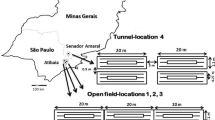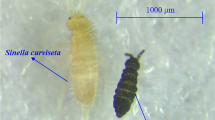Abstract
The potential of the nematophagous fungi Hirsutella rhossiliensis and Verticillium balanoides to control Ditylenchus dipsaci in white clover (Trifolium repens) was assessed in two factorial pot experiments in pasteurised soil. In experiment one, the mean dry weight of plants per pot was significantly reduced by D. dipsaci. Fungal treatment also significantly affected plant dry weight with the treatment with V. balanoides giving a higher plant weight than that in the control or the treatment with H. rhossiliensis. Numbers of D. dipsaci extracted from the foliage in each pot were significantly lower in the treatment with D. dipsaci and V. balanoides compared to those in the treatment with D. dipsaci alone or with D. dipsaci and H. rhossiliensis. In experiment two, the main effects of nematodes or fungal treatment did not significantly affect mean dry weight of plants per pot. However, nematode numbers in the foliage in the treatment with D. dipsaci and V. balanoides were significantly lower than those in the treatment with D. dipsaci. V. balanoides may be suitable for development as a biological control agent for foliar-feeding, plant-parasitic nematodes such as D. dipsaci.
Similar content being viewed by others
References
Atkinson, H.J. and Dürschner-Pelz, U. (1995) — Spore transmission and epidemiology of Verticillium balanoides, an endozoic fungal parasite of nematodes in soil. Journal of Invertebrate Pathology 65: 237–242.
Chen, T., Kilpatrick, R.A. and Rich, A.E. (1961) — Sterile culture techniques in plant nematology research. Phytopathology 51: 799–800.
Cayrol, J.C. and Frankowski, J.P. (1986) — The influence of the number of parasitizing conidia of Hirsutella rhossiliensis on the mortality of Ditylenchus dipsaci. Revue de Nematologie 9: 411–412.
Cayrol, J.C., Castet, R. and Samson, R.A. (1986) — Comparative activity of different Hirsutella species towards three plant-parasitic nematodes. Revue de Nematologie 9: 412–414.
Dackmann, C., Olsson, S., Jansson, H.B., Lundgren, B. and Nordbring-Hertz, B. (1987) — Quantification of predatory and endoparasitic nematophagous fungi in soil. Microbial Ecology 13: 89–93.
Duddington, C.L. (1955) — Notes on the techniques of handling predacious fungi. Transactions of the British Mycological Society 38: 97–103.
Fisher, R.A. and Yates, F. (1943) — Statistical Tables for Agricultural and Medical Research. 2nd edition. Oliver and Boyd Ltd., London.
Gamborg, O.L., Miller, R.A. and Ojima, K. (1968) — Nutrient requirements of suspension cultures of soybean root cells. Experimental Cell Research 50: 151–158.
Goodey, J.B. (1951) — A new species of hyphomycete attacking the stem eelworm Ditylenchus dipsaci. Transactions of the British Mycological Society 34: 270–272.
Goodey, T. (1938) — Observations on the destruction of the stem eelworm, Anguillulina dipsaci, by the fungus Arthrobotrys oligospora Fres. Journal of Helminthology 26: 159–164.
Hay, F.S. (1995) — Endoparasites infecting nematodes in New Zealand. New Zealand Journal of Botany 33: 401–407.
Hay, F.S. and Regnault, L. (1995) — Introduction of the endoparasitic nematophagous fungus Verticillium balanoides into white clover (Trifolium repens) by its host, stem nematode (Ditylenchus dipsaci). Australasian Plant Pathology 24: 249–251.
McInnis, T.M. and Jaffee, B.A. (1989) — An assay for Hirsutella rhossiliensis spores and the importance of phialides for nematode inoculation. Journal of Nematology 21: 229–234.
McKay, A.C., Fisher, J.M. and Dube, A.J. (1981) — Ecological field studies on Anguina funesta, the vector in annual ryegrass toxicity. Australian Journal of Agricultural Research 32: 917–926.
Stirling, G.R. (1991) — Biological Control of Plant Parasitic Nematodes: Progress, Problems and Prospects. CAB International, Wallingford.
West, C.P. and Steele, K.W. (1986) — Tolerance of white clover cultivars to stem nematode (Ditylenchus dipsaci). New Zealand Journal of Experimental Agriculture 14: 227–229.
White, D.R. (1984) — Plant regeneration from long term suspension cultures of white clover. Planta 162: 1–7.
Author information
Authors and Affiliations
Rights and permissions
About this article
Cite this article
Hay, F.S., Bateson, L. Effect of the nematophagous fungi Hirsutella rhossiliensis and Verticillium balanoides on stem nematode (Ditylenchus dipsaci) in white clover. Australasian Plant Pathology 26, 142–147 (1997). https://doi.org/10.1071/AP97024
Received:
Accepted:
Issue Date:
DOI: https://doi.org/10.1071/AP97024




